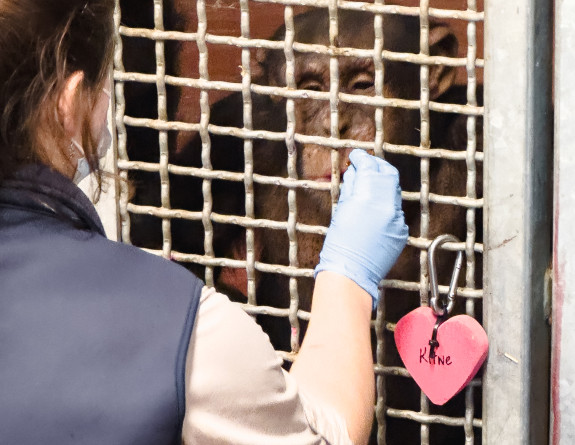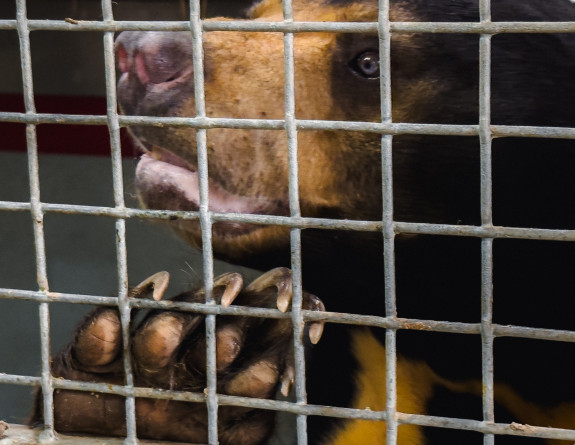
Behind the Penguin Missile launch
07 March 2025
Unfortunately you are viewing this website on an outdated browser which does not support the necessary features for us to provide an adequate experience. Please switch to a modern browser such as latest version of Google Chrome, Mozilla Firefox, Apple Safari or Microsoft Edge.
Ngā mihi nui
From willing canines to keep-your-distance tigers, there’s a world of science behind the training of animals.
Those used to working with animals know that positive reinforcement works really well. But what a dog can learn in a short time, a more challenging species might take months at the zoo.
Military dog handlers from 1 Royal New Zealand Infantry Regiment & 2 Engineer Regiment in Linton conduct annual field trips to Wellington Zoo to look at how the zoo applies animal behaviour training and science. The handlers get a behind-the-scenes look at training methods on animals ranging from tigers, sun bears and chimpanzees.
‘Training’ is something of a misnomer, since these are wild animals and it’s a zoo, not a circus. The animals are dangerous and are in an environment where they are free to exhibit natural behaviour – which usually means staying out of their space. But every so often, a zoo animal needs to receive medical treatment, including inoculations. To avoid a stressful sedation with a tranquiliser, a keeper needs their cooperation for a short moment of time.
The methodical nature of training a zoo animal is a huge contrast to teaching a dog, and it’s a tricky task that falls to Wellington Zoo animal keepers such as Holly McDonald, who specialises in the zoo’s carnivores. She trains them to present themselves to the mesh, so they can get a jab or some treatment.
“There are verbal and physical cues, the animal will present different parts of their bodies to the mesh, for keepers to check for any abnormalities.” she says.
“It sounds really simple, but this kind of training can take a while – perhaps a couple of months. Depending on the individual, it could take about two years.”



The handlers get a behind-the-scenes look at training methods on animals ranging from chimpanzees (left), tigers (centre) and sun bears (right).
Holly explained to the Army personnel how zoo handlers focus on the animal’s personality. “It’s about what really works for them. We really have to break it down, and we film our sessions and view them back, watching what the animal does, what mistakes we make, where we can improve ourselves. We write reports on what is successful and what isn’t. We’re looking at their physical well-being, their emotional and mental state, and their health.”
Food is the motivator to encourage a zoo animal to do something, but the zoo doesn’t want animals to become reward-seekers. “We are here to build relationships with animals, but we don’t want them to be looking out for us all the time. We want them to have natural behaviours.”
For her, the high point is when an animal ‘gets it’. “Senja, the female Sumatran tiger, needs to get an injection every two weeks to counter her natural allergies. I remember the time we injected her and she didn’t move. It’s knowing you can do it and the animal is calm.”

New Zealand Army: Dog handlers learn from Wellington Zoo staff
Corporal Blair Craven (1RNZIR ISD Section IC) says the zoo trips are a chance for handlers to see the latest methods in animal handling and training.
“What we see is the amount of positive training they do. The majority of our dog training is positive, but we do need to correct misbehaviours. That’s something they can’t do.”
Zoo handlers have to do a really ‘deep dive’ into animal behaviours, tailored to individual animals, he says.
“They are very methodical, a lot more leading-edge with the science. Being military, we only have a certain amount of time to get an animal ready to work, to deploy. With the zoo, they spend a lot more time on particular moments.”
The army personnel noticed similar training to theirs with the chimpanzees. “It was interesting to see how they operated as a troop. When our senior, more alpha dogs, do something in front of the younger dogs, the younger ones will learn. So quite often, when we do training, the senior dogs are on the outside, doing the work, and the less senior dogs will be in the middle, watching. At the zoo we saw how a chimp, at four months old, sits there and watches what his mum does.”
Holly says it was great having the Army dog handlers visit. “We love having them here, and they have great questions for us as well. There’s not many people we can talk about animal training that aren’t from a zoo. Each time the Army comes, I learn something new each time. When it comes to animals, there’s always something to learn.”